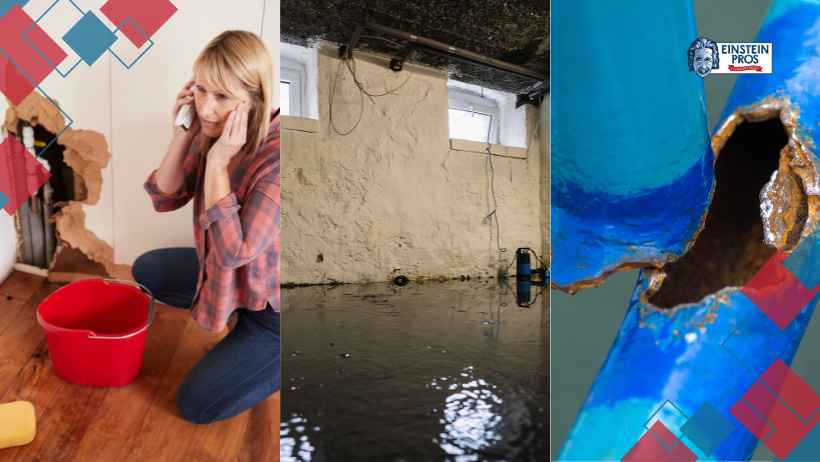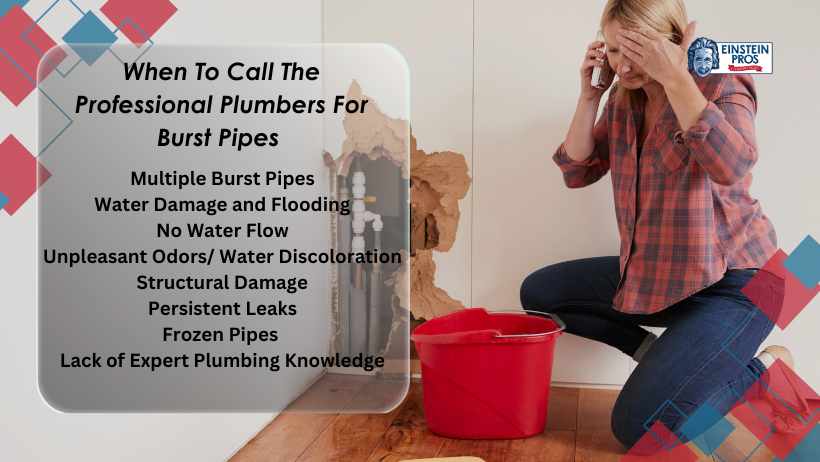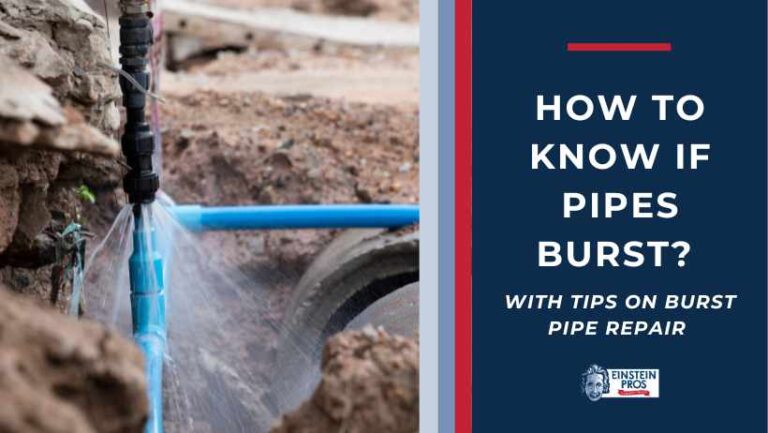Living in extremely cold places brings with it the risk of burst pipes due to freezing temperatures. It’s crucial to be knowledgeable in identifying signs of potential pipe issues to prevent extensive damage to your home. In this comprehensive guide, we’ll delve into factors to help you how to know if pipes burst, ensuring you can take swift action to mitigate any potential damage.
Signs That Your Pipes Burst
1. Unexplained Increase in Water Bills
Sudden Spikes in Water Consumption
- Keep a close eye on your monthly water bills. A sudden and unexplained increase in water consumption might be an indication of burst pipes. Check your usage patterns and compare them to previous bills; if there’s a significant deviation, it’s time to investigate further.
Check for Leaks in Visible Pipes
- Inspect the visible pipes in your home, such as those under sinks or in the basement. Look for any signs of leaks or water stains. Even a small leak can contribute to an increased water bill over time.
2. Abnormal Water Pressure
Low Water Pressure
- If you notice a sudden decrease in water pressure throughout your home, it could be a sign that the pipes are on the verge of bursting. Low water pressure can result from leaks or blockages caused by frozen water.
Water Discoloration
- Inspect the color of your tap water. Rusty or discolored water can indicate pipes deteriorating and potentially bursting. If you notice any unusual coloration, it’s essential to investigate the cause promptly.
3. Strange Noises in the Plumbing System
Banging or Clanking Sounds
- Unusual noises in your plumbing system may suggest that there are issues with your pipes. These sounds can be caused by the expansion and contraction of pipes due to temperature fluctuations, potentially leading to burst pipes. Pipe repair by experts may be necessary.
Hissing or Whistling Sounds
- Listen for hissing or whistling sounds, especially when turning on faucets or using appliances that involve water. These noises can indicate a leak or a weakened pipe structure, signaling the possibility of burst pipes.
4. Frost on Exposed Pipes
Inspect Exposed Pipes
- In colder seasons, it’s crucial to inspect exposed pipes, such as those in basements, attics, or crawl spaces. If you observe frost on the pipes, it may be an early sign that the water inside has frozen, increasing the risk of pipes bursting.
Use Insulation to Prevent Freezing
- To prevent pipes from freezing and potentially bursting, consider adding insulation to exposed pipes. Proper insulation helps maintain a consistent temperature and protects pipes from the adverse effects of extreme cold.
5. Water Stains on Walls or Ceilings
Discoloration or Water Marks
- Inspect your walls and ceilings for any signs of water stains, discoloration, or visible watermarks. These are indicators that water may be leaking from pipes within the walls or ceiling, potentially leading to burst pipes.
Bulging or Sagging Areas
- Look for bulging or sagging areas in your walls or ceilings, as these can be signs of water accumulating behind the surfaces. Addressing these issues promptly can prevent further damage and potential pipe bursts.
6. Foul Odors
Musty or Moldy Smells
- Unpleasant odors, such as musty or moldy smells, can indicate hidden water leaks. Mold growth often follows water damage, so it’s crucial to investigate the source and address any potential burst pipes if you detect such odors.
Sewage Odors
- Sewage odors in your home may suggest a more severe issue, such as a sewer line blockage or a burst pipe carrying sewage. If you notice foul smells, particularly near drains, it’s essential to address the problem promptly.
7. Wet or Damp Areas
Wet Patches on Floors or Carpets
- Keep an eye out for unexpected wet patches on floors or carpets. Even minor leaks can lead to dampness, and if left unattended, this moisture can escalate into a more significant problem like burst pipes.
Mold Growth
- Mold thrives in damp environments, and its presence may indicate water leakage. Regularly check for mold growth in areas prone to moisture, such as basements and bathrooms, to catch potential burst pipe issues early on.
8. Irregularities in the Lawn
Unexplained Puddles or Wet Areas
- If you notice unexplained puddles or consistently wet areas in your lawn, it could be a sign of an underground water leak. Pipes beneath the ground may have burst, causing water to seep into the soil.

Uneven or Soggy Ground
- Check for uneven or soggy ground around your property. This can be an indication that water is leaking from pipes underground, potentially leading to burst pipes and compromising the structural integrity of your plumbing system.
9. Water Meter Activity
How to Know if Pipes Burst? Monitor Water Meter Readings
- Regularly check your water meter readings when water is not actively being used in your home. If the meter shows activity, it could indicate a leak in your plumbing system. Sudden spikes or constant movement, when no water is being used, may signify burst pipes.
Perform a Water Meter Test
- Conduct a simple water meter test by turning off all water sources in your home and monitoring the meter for changes. Any movement in the meter, when water usage is at a standstill, may suggest a hidden leak or burst pipes, requiring immediate attention.
10. Temperature Fluctuations
Rapid Changes in Temperature
- Seattle’s weather is known for its fluctuations. Rapid changes in temperature, especially during winter, can contribute to the risk of burst pipes. Pay attention to extreme temperature variations and take preventive measures, such as insulating vulnerable pipes, to minimize the chances of pipe bursts.
Use a Thermometer to Monitor Indoor Temperatures
- Invest in a thermometer to monitor indoor temperatures, especially in areas prone to freezing. Maintaining adequate heating can prevent burst pipes from freezing and potentially bursting more. Consistent temperature control is essential in safeguarding your plumbing system during the colder months.
How To Fix Burst Pipes
1. Locating the Burst Pipe
When faced with a burst pipe, it’s crucial to identify the exact location of the damage. This step is essential for a targeted and effective repair.
- Turn off the water supply: Shut off the main water valve to stop further water damage.
- Inspect visible pipes: Check exposed pipes for visible signs of damage, such as water stains, bulges, or hissing sounds.
2. Temporary Patching
While waiting for professional assistance, consider applying a temporary patch to minimize water leakage and prevent additional damage.
- Use pipe repair tape: Wrap the damaged area with pipe repair tape, following the product’s instructions.
- Apply a pipe clamp: Secure a pipe clamp around the damaged section to provide a temporary seal.
3. Contacting Professional Help
Addressing burst pipes often requires the expertise of a professional plumber. Timely intervention can prevent further damage and ensure a thorough and lasting repair.
- Research local plumbers: Find reputable plumbers in Seattle with experience in handling burst pipes.
- Provide detailed information: When contacting a plumber, provide as much information as possible about the issue to expedite the repair process.
4. Thawing Frozen Pipes
If freezing temperatures have caused your pipes to burst, it’s crucial to thaw them safely to prevent further damage.
- Open faucets: Turn on faucets connected to the affected pipe to relieve pressure as the ice thaws.
- Use gentle heat sources: Apply heat to the frozen area using a hair dryer, heating pad, or towels soaked in hot water.
5. Preventive Measures for the Future
Once you’ve addressed the immediate issue, it’s essential to take preventive measures to avoid future burst pipes in Seattle.
- Insulate pipes: Ensure that all vulnerable pipes are properly insulated to prevent freezing.
- Schedule regular maintenance: Implement a routine maintenance schedule, including professional inspections and necessary repairs.
6. Using a Pipe Repair Clamp
In cases where a temporary patch may not be sufficient, a pipe repair clamp can be a more robust solution. These clamps are designed to provide a strong and durable seal around the damaged area.
- Choose the right size: Ensure the pipe repair clamp matches the diameter of your pipe for an effective and secure fit.
- Follow manufacturer instructions: Install the clamp according to the provided guidelines to maximize its effectiveness.
7. Thoroughly Inspecting Hidden Pipes
While visible pipes are easier to inspect, hidden pipes within walls or ceilings can also be prone to bursts. A thorough examination of concealed plumbing can help identify and address issues promptly.
- Use a stud finder: Locate the studs in your walls to determine where pipes are likely to be located.
- Listen for water flow: Turn off all appliances and faucets, then listen to the sound of running water, which can indicate a hidden leak.
8. Employing Epoxy Putty for Quick Repairs
Epoxy putty is a versatile and durable material that can be used for on-the-spot repairs. It hardens quickly, creating a strong and long-lasting seal around the burst pipe.
- Clean the area: Ensure the damaged section is free from water and debris before applying epoxy putty.
- Knead and apply: Follow the manufacturer’s instructions to knead the putty and apply it directly to the leaking area.
9. Utilizing Pipe Sleeves for Insulation
Pipe sleeves provide an additional layer of insulation, especially in areas prone to extreme temperatures. These sleeves are easy to install and can prevent pipes from freezing in the first place.
- Measure and cut accurately: Choose the right size of pipe sleeve and cut it to fit the length of the exposed pipe.
- Secure with tape: Use duct tape to secure the sleeve in place, ensuring complete coverage.
10. Installing Heat Tape for Continuous Warmth
Heat tape, also known as heat cable, can be an effective solution to prevent freezing and address existing issues. It provides consistent heat to the pipes, preventing ice buildup.
- Wrap the pipe evenly: Apply heat tape along the length of the exposed pipe, ensuring even coverage.
- Secure with insulation: Once the heat tape is in place, add additional insulation to enhance its effectiveness.
11. Ensuring Adequate Ventilation in Crawl Spaces
Crawl spaces are often overlooked but can be significant contributors to burst pipes. Proper ventilation is essential to maintain a consistent temperature and prevent freezing.
- Install vents strategically: Place vents in crawl spaces to promote airflow and maintain a more stable temperature.
- Seal gaps and cracks: Prevent cold air from entering crawl spaces by sealing any openings with insulation or caulk.
12. Investing in Smart Home Leak Detection Systems
Modern technology offers smart solutions to detect leaks and burst pipes early on. Smart home devices equipped with leak sensors can provide real-time alerts, allowing for swift action.
- Place sensors strategically: Install smart leak sensors near potential problem areas, such as water heaters, under sinks, and in basements.
- Connect to a monitoring system: Ensure that the sensors are integrated into a monitoring system that alerts you via smartphone or other devices.

When To Call The Professional Plumbers
1. Multiple Burst Pipes
If you’re facing the unfortunate scenario of multiple burst pipes simultaneously, it’s a clear signal to call in a professional from Einstein Pros. This situation may indicate a more significant issue within your plumbing system, such as high water pressure or extensive deterioration of pipes. A licensed plumber can assess the extent of the damage and implement comprehensive solutions to address the root cause.
2. Water Damage and Flooding
When a burst frozen pipe leads to water damage and flooding, immediate professional intervention is crucial. Water can cause structural damage to your home, promote mold growth, and damage personal belongings. Professional plumbers have the expertise and equipment to handle water extraction, drying, and restoration, preventing long-term consequences.
3. No Water Flow or Low Water Pressure
If you notice a sudden decrease in water flow or low water pressure throughout your home, it may indicate a severe blockage or burst pipe. While you can attempt to troubleshoot by checking faucets and visible pipes, a professional plumber can conduct a more comprehensive inspection, including using specialized tools to identify and resolve the issue.
4. Unpleasant Odors or Discoloration in Water
Unpleasant odors or discoloration in your tap water can be signs of contamination due to a burst pipe. If your water smells foul or appears discolored, it may indicate the presence of bacteria, rust, or other contaminants. Professional plumbers can conduct water quality tests, locate the source of the issue, and implement appropriate measures to ensure your water is safe for use.
5. Visible Signs of Structural Damage
Burst pipes can lead to structural damage, including sagging ceilings, warped walls, or compromised foundations. If you observe any of these visible signs, it’s essential to seek professional assistance promptly. Plumbers can assess the structural integrity of your home, address underlying issues, and collaborate with other professionals, such as contractors if extensive repairs are needed.
6. Persistent Leaks Despite DIY Attempts
While temporary fixes can be helpful in emergencies, persistent leaks despite your DIY efforts may indicate a more complex problem. Professional plumbers have the experience to identify underlying issues that may be contributing to repeated leaks. Calling in a professional ensures a thorough examination of your plumbing system and the implementation of long-term solutions.
7. Frozen Pipes that Cannot be Thawed Safely
Attempting to thaw frozen pipes is a common DIY approach, but it’s crucial to recognize when the situation requires professional intervention. If your attempts to thaw frozen pipes are unsuccessful or if you’re concerned about causing further damage, it’s time to call a plumber. They have the expertise to safely thaw pipes and assess any resulting damage.
8. Lack of Plumbing Knowledge and Experience
If you lack the necessary plumbing knowledge and experience, it’s wise to consult a professional from the outset. Working with pressurized water systems and intricate plumbing configurations requires a certain level of expertise. Calling a professional ensures that the repair is carried out efficiently and reduces the risk of mistakes that could lead to more extensive damage.
Conclusion
Being aware of the signs of burst pipes is crucial for homeowners in Seattle, Washington, where cold weather can pose a significant risk. Regular inspections by professional plumbers at Einstein Pros, prompt attention to irregularities, and preventive measures such as insulation can help you avoid the costly consequences of burst pipes. Stay vigilant, address issues promptly, and protect your home from the potential damage associated with plumbing emergencies.
